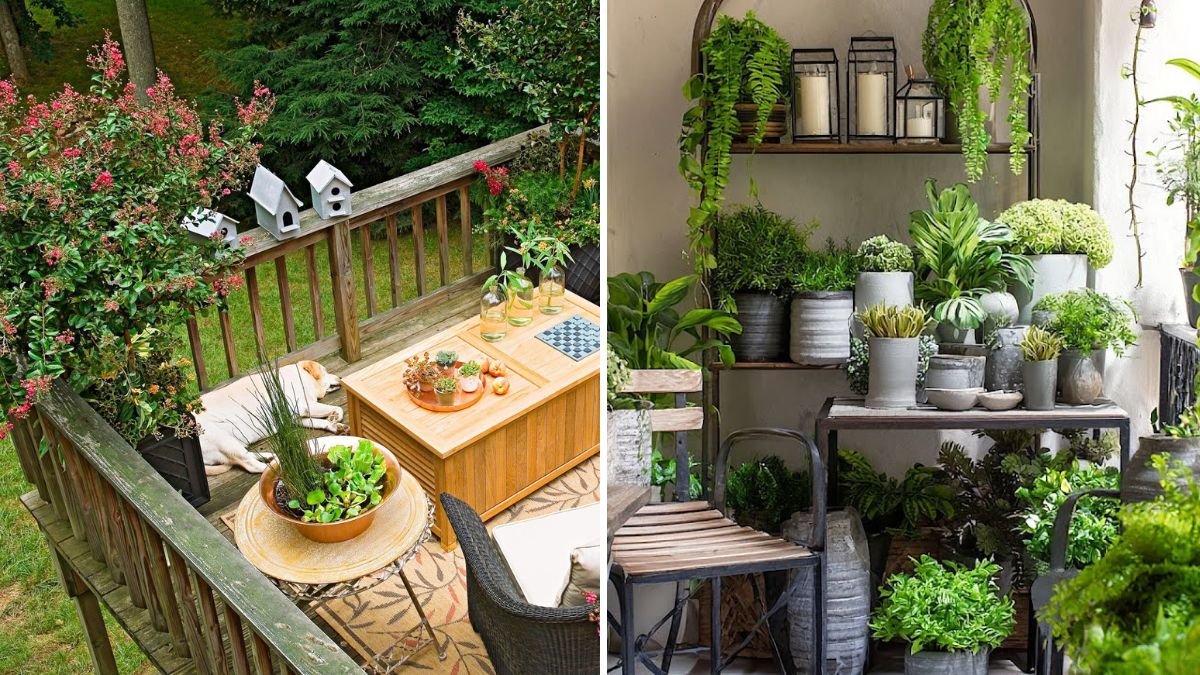Creating a balcony garden that feels lush and inviting can transform even the smallest urban space into a vibrant, green sanctuary. A well-designed balcony garden not only enhances the aesthetics of your home but also promotes relaxation, improves air quality, and provides a personal connection to nature. Achieving a lush, verdant feel requires careful planning, plant selection, layout design, and ongoing maintenance.
This article explores how to design a balcony garden that feels lush, providing guidance on space optimization, plant selection, layering techniques, container choices, color schemes, and maintenance strategies for an abundant and thriving balcony garden.
1. Assessing Your Balcony Space
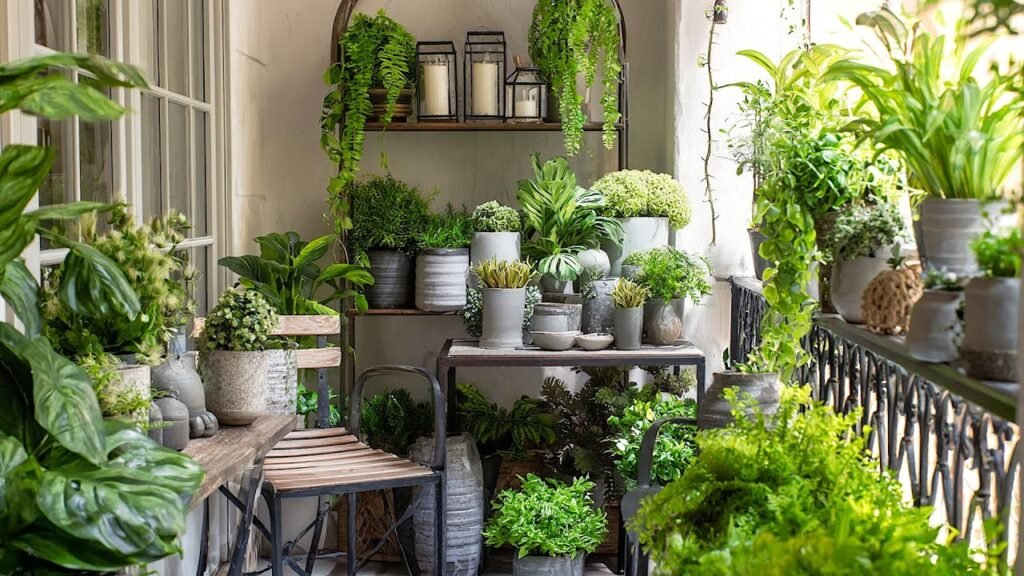
The first step in creating a lush balcony garden is understanding the space available:
- Size and Shape: Measure your balcony dimensions to determine the types and sizes of containers and furniture that can fit comfortably.
- Weight Capacity: Ensure the balcony can support the weight of soil, pots, and plants, especially if using large containers or vertical structures.
- Sunlight Exposure: Identify areas of full sun, partial sun, and shade to select suitable plants for each microclimate.
- Wind and Weather: Consider exposure to wind or rain, which can influence plant placement and container stability.
A clear assessment allows you to design efficiently, ensuring all plants thrive and the space feels cohesive and lush.
2. Choosing the Right Plants
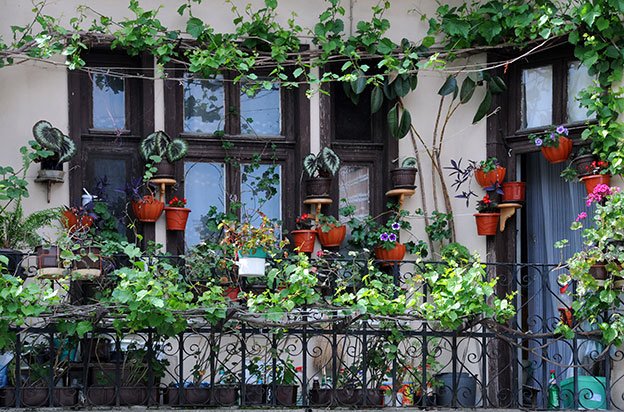
Plant selection is the cornerstone of a lush balcony garden:
- Foliage Plants: Plants with large, textured, or colorful leaves—like caladiums, elephant ears, ferns, or philodendrons—create a dense, tropical feel.
- Flowering Annuals and Perennials: Petunias, geraniums, impatiens, begonias, and marigolds provide vibrant colors and seasonal interest.
- Trailing and Cascading Plants: Lobelia, ivy, fuchsia, and nasturtium soften edges and create a sense of fullness over railings and shelves.
- Compact Trees and Shrubs: Dwarf citrus, ficus, or boxwood add height, structure, and privacy.
- Herbs and Edibles: Basil, mint, tomatoes, and strawberries add greenery, fragrance, and functional benefits.
Combining different textures, heights, and colors creates depth and makes the balcony feel verdant and abundant.
3. Using Layering and Vertical Gardening Techniques
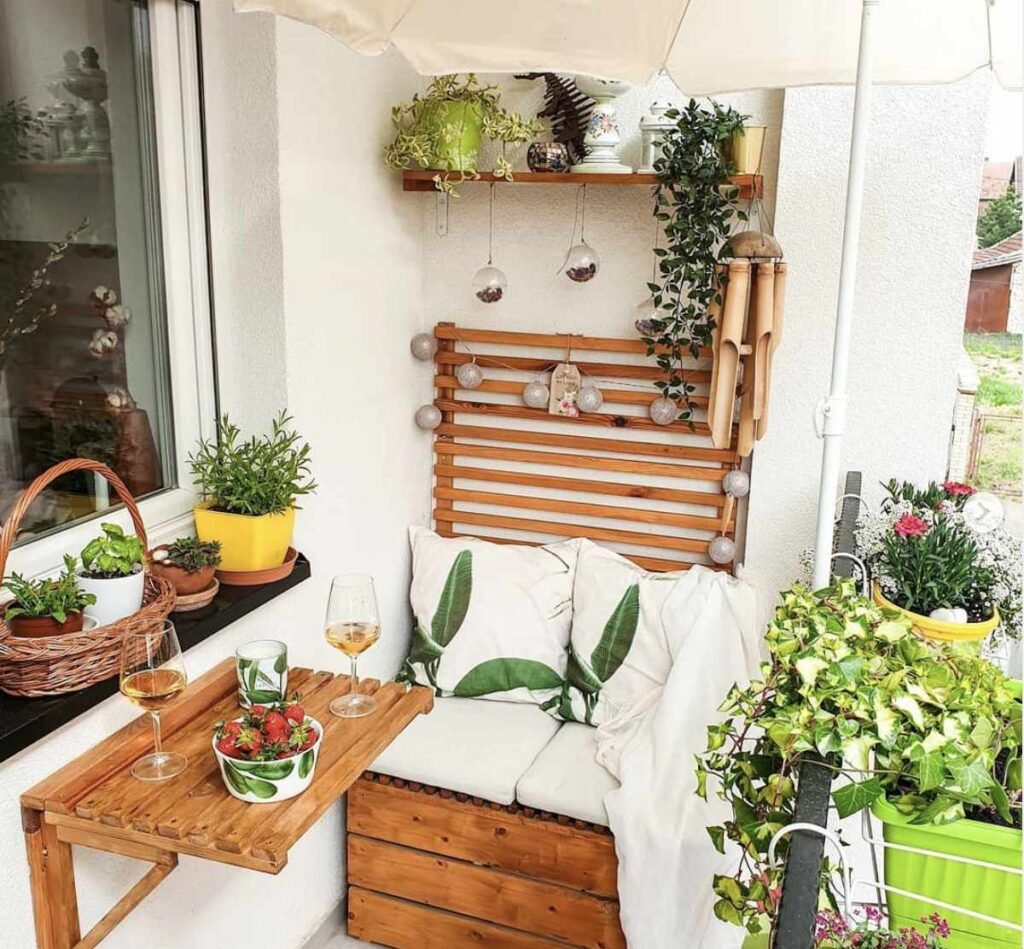
Layering is essential to creating the illusion of a lush garden in a small space:
- Vertical Planting: Use wall-mounted planters, hanging baskets, or trellises to grow plants vertically, freeing floor space while adding density.
- Tiered Shelving: Stack pots or use plant stands to create multiple layers of foliage.
- Height Variation: Arrange taller plants at the back and shorter plants in front to mimic natural layering.
- Trailing Plants: Place trailing plants on high surfaces to cascade downward, filling empty vertical space.
These techniques give a multi-dimensional, dense appearance, making even a small balcony feel like a jungle oasis.
4. Choosing Containers for a Lush Look
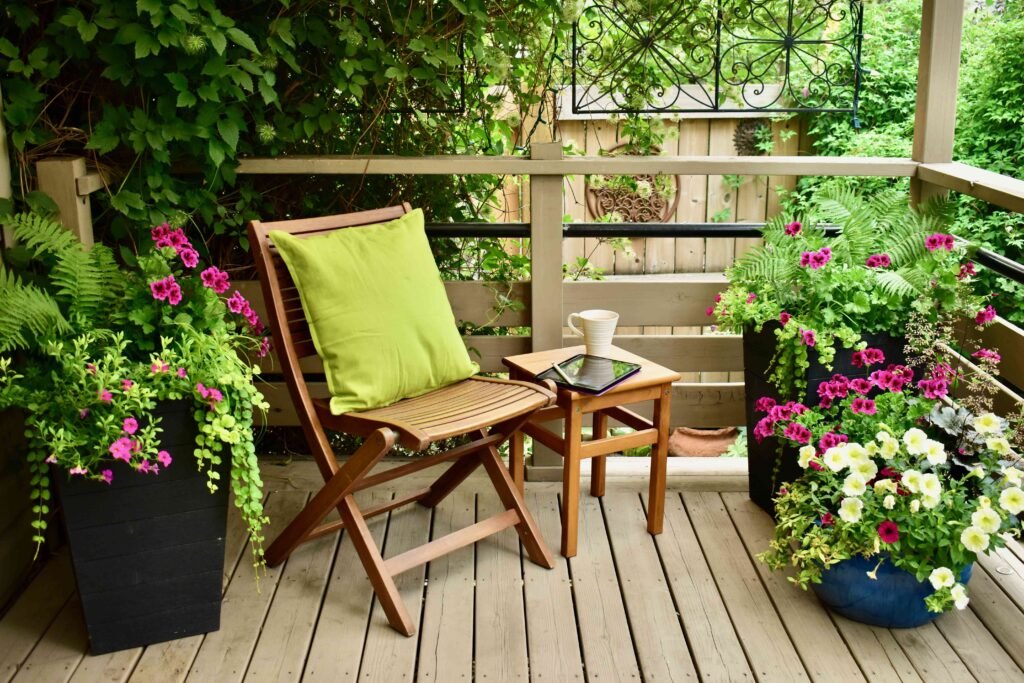
Containers influence both plant health and aesthetics:
- Material: Clay, ceramic, wood, and plastic all offer different visual and functional benefits. Clay and wood add natural warmth, while plastic is lightweight and versatile.
- Size: Ensure pots are deep and wide enough to support healthy root growth. Small containers for shallow-rooted plants, large containers for trees or shrubs.
- Color and Design: Use earthy tones or colors that complement your balcony décor. Coordinated or contrasting pot colors can enhance the overall visual appeal.
- Mobility: Lightweight pots or ones with wheels allow easy repositioning for sunlight or design changes.
The right containers support healthy growth and contribute to the lush, layered aesthetic of your balcony garden.
5. Optimizing Sunlight and Microclimates
Different plants have varying light requirements:
- Full Sun Areas: Ideal for flowering annuals, dwarf citrus, and tomatoes.
- Partial Sun/Shade: Suitable for ferns, impatiens, begonias, and philodendrons.
- Microclimates: Corners, railings, or balconies with partial shelter can create unique niches for sensitive plants.
Understanding your balcony’s sunlight patterns ensures plants thrive, contributing to a healthy, lush environment.
6. Designing for Privacy and Comfort
A lush balcony garden is more than plants—it’s a retreat:
- Screens and Trellises: Use bamboo screens, lattice panels, or tall plants to create privacy from neighbors.
- Seating Integration: Include a small bench, chair, or swing surrounded by plants for a cozy, immersive experience.
- Shade Elements: Umbrellas or retractable awnings protect delicate plants and create comfortable seating areas.
- Water Features: Small fountains or birdbaths add sound and movement, enhancing the feeling of a lush retreat.
Designing with privacy, comfort, and sensory experiences amplifies the lushness of the garden.
7. Soil and Fertilization for Thriving Growth
Healthy soil is vital for lush greenery:
- Well-Draining Soil: Use lightweight potting mixes with perlite, vermiculite, or sand to prevent waterlogging.
- Moisture Retention: Incorporate organic matter like compost, coconut coir, or peat moss to maintain moisture.
- Fertilization: Regular feeding with slow-release or liquid fertilizers encourages vigorous growth.
- Soil Refreshing: Replace topsoil or repot plants annually to maintain nutrient availability.
Rich, well-maintained soil supports dense foliage, vibrant blooms, and continuous growth.
8. Watering and Maintenance
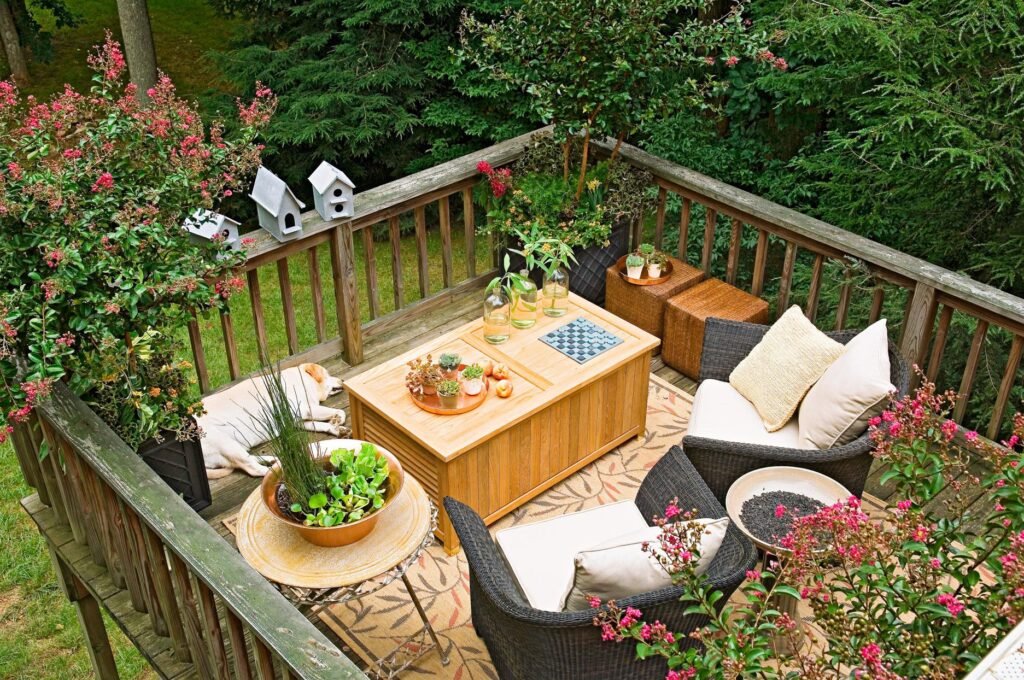
Regular care is essential for a lush balcony garden:
- Watering: Containers dry out faster; water deeply and consistently, adjusting for plant type and season.
- Mulching: Mulch retains soil moisture and regulates temperature.
- Pruning: Remove dead leaves, faded flowers, and weak branches to encourage new growth.
- Pest Control: Monitor for aphids, spider mites, or fungal infections; use organic or chemical remedies as needed.
- Cleaning: Wash pots, trays, and surfaces to prevent algae or moss buildup.
Consistent maintenance ensures plants remain healthy, dense, and visually appealing.
9. Color Schemes and Aesthetic Coordination
Color selection enhances the lushness of your balcony:
- Monochromatic Theme: Use different shades of one color for a sophisticated, unified look.
- Complementary Colors: Combine contrasting colors to create visual interest and vibrancy.
- Seasonal Rotation: Change flowering annuals seasonally to maintain a fresh, colorful display.
- Foliage Variety: Mix leaf colors, shapes, and textures to add depth and richness beyond flowers.
A carefully planned color palette enhances the perception of abundance and lushness.
10. Creative Design Ideas
- Hanging Garden: Suspend multiple baskets at different heights for a cascading jungle effect.
- Tiered Balcony: Use multi-level stands to layer plants vertically while maintaining accessibility.
- Edible Balcony: Integrate herbs, tomatoes, strawberries, and dwarf citrus with flowering plants.
- Mixed Textures: Combine broad-leafed plants, fine ferns, and trailing vines for a dense, textured look.
- Miniature Water Feature: Add a small fountain or pond to mimic a natural environment, enhancing lushness.
Creative combinations of plant types, textures, and structures make a compact balcony feel expansive and alive.
11. Seasonal Considerations
Lushness can vary with the seasons, requiring planning:
- Spring/Summer: Use flowering annuals, lush foliage plants, and trailing vines for peak color.
- Autumn: Incorporate ornamental cabbages, chrysanthemums, and colorful foliage plants.
- Winter: Protect tropical and tender plants indoors or use hardy evergreens for continuous greenery.
- Rotation and Replacement: Replace spent annuals and refresh seasonal plants to maintain fullness.
Seasonal planning ensures your balcony remains dense, colorful, and inviting throughout the year.
12. Benefits of a Lush Balcony Garden
- Space Optimization: Creates a full, green environment even in small urban spaces.
- Stress Reduction: Dense greenery promotes relaxation and mental well-being.
- Air Quality Improvement: Plants filter dust, toxins, and pollutants.
- Aesthetic Appeal: Adds beauty, charm, and visual interest to urban living.
- Biodiversity: Attracts birds, butterflies, and pollinators to your balcony.
- Practicality: Provides fresh herbs, edible plants, and micro-garden produce.
A lush balcony garden combines practicality, beauty, and serenity, enhancing urban living quality.
Conclusion
Designing a balcony garden that feels lush is a rewarding project that transforms urban spaces into green sanctuaries. By carefully assessing your space, selecting the right plants, layering foliage and flowers, choosing appropriate containers, and maintaining healthy soil and watering routines, even a small balcony can feel abundant and verdant.
Incorporating vertical planting, trailing plants, varied textures, and seasonal color rotation enhances the illusion of density, creating a garden that feels rich, vibrant, and immersive. Thoughtful design elements like privacy screens, seating, and creative décor further elevate the space, making it both functional and aesthetically pleasing.
A lush balcony garden is not just about the number of plants—it’s about smart planning, thoughtful layering, continuous care, and creative design. With the right approach, even limited urban spaces can be transformed into luxurious, flourishing gardens that bring nature’s beauty and serenity close to home.
